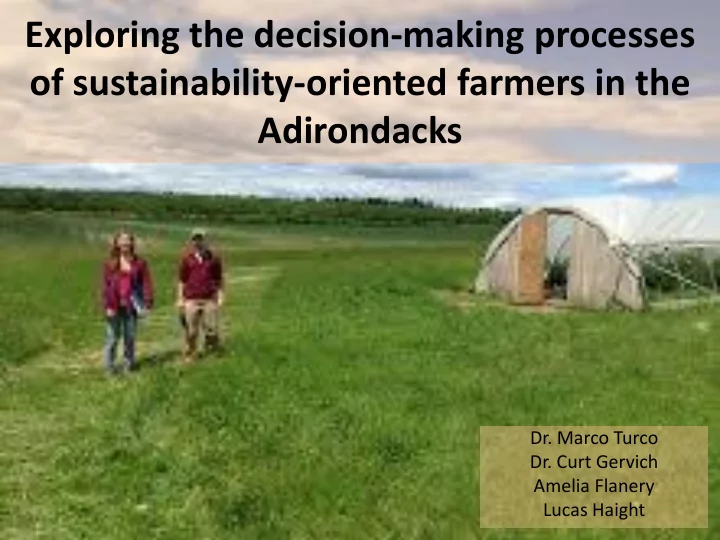

Exploring the decision-making processes of sustainability-oriented farmers in the Adirondacks Dr. Marco Turco Dr. Curt Gervich Amelia Flanery Lucas Haight
Sustainable Agriculture in the ADKs What we’ve got going for us • Ethic of self-reliance and sustainability • High profile leaders • Growing community of producers and consumers
Our challenges • Climate and growing season – 6 months of winter, short days, extreme cold – May 15 frost date • Inexperience – Financial literacy – Marketing – Management • Lack of credit – new farmers especially need ongoing cash flow
Research Questions Research Questions • What are the typical processes that growers use to make decisions? • What are some of the decision-making challenges that farmers face as they make decisions? • Can farmers identify best practices of decision making?
Project Objectives • Learn about decision making practices • Identify limitations and opportunities for enhancement • Involve students
Methods • Four phase methodology 1. Survey to gather farm details 2. Semi-structured interview to learn about on-farm decisions 3. Follow-up interview to explore decision making processes 4. Develop case studies • Sample – n = 13 – Clinton and Essex Counties – Sustainability-oriented missions
Results Acreage Diversified Livestock/meat Dairy Veggie 17-1700acres 9 8 4 (median=130) Commodity CSA Farmers Direct to Markets Markets Restaurant Total Farms 2 7 7 7 n = 13 Non-family “conventional” USDA Organic Free-range, paid methods (non-certified) Grass-fed employees (USDA), Naturally grown 1-16 3 1(7) 5 (median = 5)
Results Number of farms that self identify success at meeting… Economic goals Environmental Social goals goals Highly Successful 0 3 2 Successful 9 6 9 Unsuccessful 1 0 0 Highly Unsuccessful 2 2 2
Case study development 1. Manzini Farms (grapes to sheep) 2. Juniper Hill (improving employee communication/ management) 3. Essex Farm (creating a NYC CSA) 4. Mace Chasm Farm (launch farm-to-door winter meat delivery)
Decision Making for Sustainable Agricultural Production in the Humid, Temperate North-East of the USA Case Study: Manzini Farm, Keeseville, NY Table Grapes to Lamb Production
Facts / Numbers / Money • Grow and Finish 36 lambs per acre • Harvested at 100 lbs (9 months) • Carcass weight of 46 lbs • Total of 1,656 lbs per acre • Lamb sold at $12.42 per lb ‘hanging weight’ • Gross Income of $20,567.52 per acre • Cost of Production: $46.72 per acre • Total Profit: $20,520.80
GRAPES to SHEEP (Medium Term Time Frame) Start of Enterprise: Reasons for the Selection of Table Grapes as an enterprise: Financial and Environmental considerations the initial criteria
Start Up • No Local Competition • Local CSAs and Farmer’s Markets eager to sell on our behalf • Cheap Land available • Able to start on small acreage • Adequate Environmental Factors – Water Sunlight (Heat Units, Photoperiods, etc) Air Flow Soil ‘type’.
Reasons (cont) • Available, skilled Labour for Planting and Trellis construction. • Available Owner Capital, or low-interest agricultural Loans. • High Productivity once in full Production – 5th Year. • Inter-row species Diversity: Plant and Animal. • Medium resilience.
Facts / Numbers / Money • Planted 605 vines per acre (8’x9’ spacing). • At full production estimated Yield: 7lbs per vine. • 4,235lbs of Reliance table grapes per acre. • 4,000lbs of marketable grapes per acre. • Grapes sold in 1lb bags at $3.00 • Estimated Gross Income per acre: $12,000.
CHALLENGES and the SUSTAINABILITY AGENDA • Output Stability – Medium Yield Certainty • Low Flexibility – Low adaptability (‘Locked’ into the model) • Reliance on both Human and Commodity External Inputs • Low internal Nutrient Cycling • “Sustainability” with a wide open Nutrient Loop is difficult if not factually impossible.
Decision-Making Criteria to change from Table Grapes to Lamb Production Economic Viability • Efficiency of Inputs • Meeting Market requirements • Net-Farm Profitability
Institutional Manageability • Labour Availability and Skill. • Security of Water Supply. • Imports as a percentage of merchantable Exports.
Agrotechnical Adaptability • Access to Ground Water • Production Density • Weed Control / Invasive Species • Pest Control (External & Internal)
Environmental Soundness • Soil Conditions • Influence of new system on Soil • Influence of new system on Waterways • Attractiveness of Real Estate
Facts / Numbers / Money • Grow and Finish 36 lambs per acre • Harvested at 100 lbs (9 months) • Carcass weight of 46 lbs • Total of 1,656 lbs per acre • Lamb sold at $12.42 per lb ‘hanging weight’ • Gross Income of $20,567.52 per acre • Cost of Production: $46.72 per acre • Total Profit: $20,520.80
Conclusions • Diversity of farm produce, markets • Moderate sustainability practices – Focus on biological and social practices – Lack economic awareness • Wide variety and inconsistent decision making – Case studies show successes and failures • Most farms report success in one or more areas – Lack unified definition of success
Challenge Questions • Do conventional measures of success apply to sustainability-oriented farms? – How can they? • Great diversity in farm types, markets, etc. – Do these farmers care about conventional measures? • “ Quando guardiamo uno, vediamo molti ” – If they do, why do they claim success when conventional measures suggest otherwise?
Conclusions about Decision Processes Decision Making Best Practices Decision Making Challenges • Form over function decisions • Clarify objectives – short-sighted – emotive • Think long term • Only see short-term decision • But act short term horizon – Patience and resilience – Think long term, act short term – Patience and resilience • Multiple objectives • “ Quando guardiamo uno, • Myopic view of decision vediamo molti ” • Collecting and using data • Recognizing and applying useful data
Recommend
More recommend